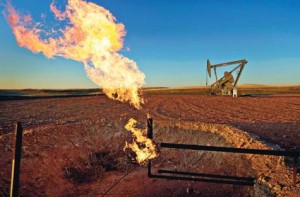 Brent folded some gains on Fridays session in Europe, after a sharp exchange of words on Thursday, following the deaths of pro-Russian separatists in Ukraine pushed crude up. Meanwhile, West Texas Intermediate dropped, pressured by a bearish report on US stockpiles, after also gaining some on Ukraine yesterday. Natural gas continued dropping after a bearish report on US storage levels, though big drops were pared by cooler weather.
Brent folded some gains on Fridays session in Europe, after a sharp exchange of words on Thursday, following the deaths of pro-Russian separatists in Ukraine pushed crude up. Meanwhile, West Texas Intermediate dropped, pressured by a bearish report on US stockpiles, after also gaining some on Ukraine yesterday. Natural gas continued dropping after a bearish report on US storage levels, though big drops were pared by cooler weather.
West Texas Intermediate futures for settlement in June traded for $100.62 per barrel at 13:39 GMT, losing 1.29% on the New York Mercantile Exchange. Daily high and low stood at $102.05 and $100.53 per barrel, respectively, registering the deepest trough in three weeks. Over the last three trading days the US crude benchmark lost 1.64%, though yesterday it added 0.49%, on tensions in Ukraine.
Meanwhile on the ICE, Brent futures for June delivery registered a 0.48% loss to trade for $109.80 per barrel at 13:39 GMT, prices ranging from $109.73 to $110.63 per barrel, reaching the highest price level since early March. Brent’s premium to WTI stood at $9.18.
Brent and WTI are headed in different directions as Ukraine supports the European benchmark, while record-high supplies in the US are pressuring the American brand. “U.S. inventories are weighing on WTI, whilst increasing tension in Eastern Ukraine have been supporting Brent,” Carsten Fritsch, analyst at Commerzbank AG in Frankfurt, said by e-mail for Bloomberg. “It’s rather unlikely the spread will narrow unless the situation in Ukraine eases. Crude processing in the U.S. is at a very high level for this time of year, so the stockpile increase is rather supply-driven.”
Ukraine crisis escalation
The heating of tensions in Ukraine was the strongest force behind crude gains yesterday. The interim government reported that security forces had killed at least two pro-Russian separatists. The raids prompted Russian President Vladimir Putin to warn the pro-western authorities in Kiev that they will face “consequences”, while ordering troops near the border to begin military exercises. A Russian TV station quoted Vitaly Churkin, Moscow’s ambassador to the UN, as saying that Russia would have legal basis to send “peacekeepers” to Ukraine.
According to the Interfax-Ukraine news agency, acting Ukrainian defense minister said on Friday that Moscow has tens of thousands of troops along the border and that they had come within a kilometer of the frontier. Yesterday the UK said that Russian aircraft were detected approaching northern Scotland, and the Netherlands, Denmark and the United Kingdom all sent jets to escort the approaching aircraft away from their airspace.
Elsewhere, the BBC reported that accounts from the port city of Odessa indicated that an explosion at a checkpoint injured at least seven people earlier today.
The Kremlin asked the US to exercise its influence and persuade the Ukrainian government to stop its crackdown on the eastern separatists. At the same time the US accused Moscow of inciting the unrest. US Secretary of State John Kerry said: “Not a single Russian official has publicly gone on television in Ukraine and called on the separatists to support the Geneva agreement.” He added that US intelligence was certain Russia was “playing an active role in destabilizing eastern Ukraine with personnel, weapons, money and operational planning.” Reuters reported that U.S. President Barack Obama will try to agree more coordinated sanctions against Russia when speaking to European leaders today, according to anonymous sources.
US inventories
Wednesday saw a bearish report on crude supplies in the United States pressure oil prices, and especially WTI, as the Energy Information Administration reported stockpiles in the US were at their highest level on record. Supplies rose by 3.524 million barrels in the week through April 18th, to reach 397.7 million, exceeding expectations of a 2.3-million barrels increase. Crude imports and domestic production outpaced refinery utilization rate, even though it also picked-up pace, to score 91.0%, up from last week’s 88.8%.
Motor gasoline and distillates figures also fanned significantly negative sentiment, with gasoline inventories having dropped by 0.274 million barrels for the week, far below expectations of a 1.713-million decline, while distillate fuels gained 0.597 million barrels in supplies, in contrast to a forecast of a 0.463-million decline.
“There’s a huge amount of crude in the U.S., which should keep a lid on prices. Any rally will soon come under pressure.” said for Bloomberg Addison Armstrong, director of market research at Tradition Energy in Stamford, Connecticut.
Natural gas futures
Natural gas futures due in June dropped by 0.78% at the new York Mercantile Exchange today, to trade for $4.686 per million British thermal units at 13:46 GMT, registering the lowest price in 2 weeks earlier at $4.679 per mBtu. Yesterday futures declined 0.51% on a daily basis, after rising inventories in the US reversed earlier gains on cooler weather. The contract has lost 0.63% this week, after adding 4.5% last Thursday.
Natgasweather.com reported much of the central and north-eastern states will experience cooler than normal weather in the next few days, before a slowly moving cold system from Canada tracks in next week to halt readings at below-average for much of the central, eastern and some of the southern US. Meanwhile, the South will be warming-up for the next day or two, before a storm from the West cools the region. Over the next few weeks expectations are the active weather will persist, with periods of cool blasts, including Spring storms, followed by warming in some regions. Overall, the following days and weeks will see cooler than average weather, forecasting a slightly higher demand for heating.
Accuweather.com reported that New York is set for an average day for April 25th, with temperatures ranging from 49 to 61 degrees Fahrenheit. Saturday will also be quite normal, before weather begins to slightly cool on Sunday and into next week, when readings will drop to as little as 46 degrees. For Boston Friday will be slightly warmer than Thursday, with readings between 44 and 60. During the weekend, however, temperatures will drop to 5-6 degrees below average, ranging from 40 to 53 degrees. In the mid-west, Chicago will be warmer today, with temps between 49 and 65 or 2-3 above average. Saturday, in sharp contrast, will bring impressive cold, with readings dropping as much as 10 degrees, before a slow warm-up starting on Sunday and through next week.
Gas stockpiles in the US
Yesterday the Energy Information Administration released its weekly natural gas storage report for the week ended April 18th, which revealed a growth of 49 billion cubic feet in inventories, exceeding forecasts of a 44 bcf gain. It exceeded the previous week’s figure of a 24 bcf increase, bringing the volume of natural gas in storage to 899 bcf. Improving supplies push down on the blue fuel, though, after the harsh winter in the US drained the nation’s storage hubs. Even with last week’s gains the figure is still 52.9% below the 5-year average and prices remain at higher levels than before.
The previous report induced a major shift in the market, as natural gas rallied on better-than-expected demand. The government agency reported that US natural gas inventories rose by 24 billion cubic feet in the seven days through April 11th, compared to analysts’ forecasts for a 34-bcf jump, bumping prices 4.51%.





